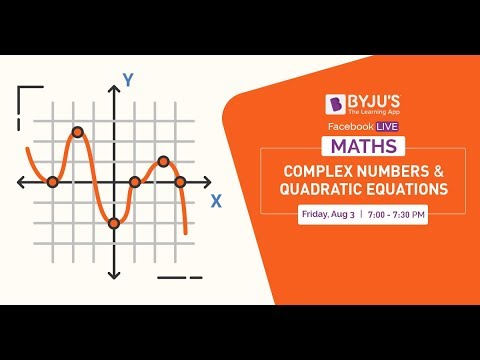An equation of the form ax2 + bx + c = 0 is called a quadratic equation, where a, b, and c are real numbers and a ≠ 0. A quadratic equation has complex roots if its discriminant is less than zero. We can find the square root of negative real numbers in the set of complex numbers. A number that can be expressed in the form a + ib is referred to as a complex number. Here a and b are real numbers. The value of i equals √-1.
Complex numbers and quadratic equations are one of the most important chapters in the preparation of competitive entrance exams. Students can expect 1-3 questions from this topic for JEE Main and other exams. In this article, we will learn how to solve complex quadratic equations.
Methods to Find Complex Roots of a Quadratic Equation
1. The solutions to the above equation are available in the set of complex numbers which are given by
2. If the equation is of the form z2 = (x + iy)2, expand the expression and equate real part and imaginary part. Then solve for x and y.
Solved Examples
Let us have a look at some examples.
Example 1:
Solve the equation 2x2 + x + 1 = 0
Solution:
Given 2x2 + x + 1 = 0
b2 – 4ac = 1 – 4×2×1
= 1 – 8
= -7
-7 < 0
So x = ( – 1 ± √7 i )/4
Hence the roots are ( – 1 + √7 i )/4 and ( – 1 – √7 i )/4.
Example 2:
Solve x2 + 3x + 5 = 0
Solution:
Given x2 + 3x + 5 = 0
b2 – 4ac = 32 – 4×1×5
= 9 – 20
= -11
< 0
x = (- 3 ± √11 i)/2
Hence the roots are ( – 3 + √11 i )/2 and ( – 3 – √11 i )/2.
Example 3.
Solve z2 = (x + iy)2 = 15 + 8i
Solution:
z2 = (x + iy)2 = 15 + 8i
(x + iy)2 = (x2 – y2) + 2xyi = 15 + 8i
Comparing real and imaginary part
x2 – y2 = 15 …(i)
2xyi = 8i
xy = 8/2 = 4
The factors of 4 are (4,1) (-4,-1), (2,2) and (-2,-2).
Substitute these values in (i) and check which value satisfies the equation.
We get (4,1) and (-4, -1) satisfies (i).
Hence, z = 4 + i or -4 – i are the roots of the equation.
Example 4.
Find the roots of x2+4x+5 = 0.
Solution:
Given x2+4x+5 = 0.
b2-4ac = 16-4(1)(5)
= -4<0
We apply the quadratic formula.
x = (-4±√-4)/2(1)
= (-4±2i)/2
= -2±i
Quadratic Equations

Location of Roots

Complex Numbers and Quadratic Equations

Also Read
Frequently Asked Questions
How do you identify whether a quadratic equation has complex roots?
A quadratic equation has complex roots if its discriminant is less than zero. b2-4ac < 0.
Give the equation to find the roots of a quadratic equation.
The roots of a quadratic equation is given by the formula, x = (-b±√(b2-4ac))/2a.
How do you find the complex roots of a quadratic equation?
The complex roots of a quadratic equation with real coefficients occur in complex conjugate pairs. We use the formula x = (-b±i√(4ac – b2))/2a. So, if z = p+iq is a root of a quadratic equation with real coefficients, then the other root is z = p-iq.
Does the quadratic formula work for complex numbers?
Yes. Quadratic formula works for complex numbers.

Comments